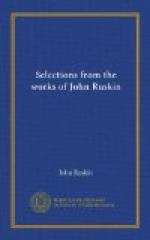From Chillon’s snow-white battlement.
Why snow-white? Because castle battlements are not usually snow-white. This is another added detail, and a detail quite peculiar to Chillon, and therefore exactly the most striking word in the whole passage.
“Battlement”! Why battlement? Because all walls have not battlements, and the addition of the term marks the castle to be not merely a prison, but a fortress.
This is a curious result. Instead of finding, as we expected, the poetry distinguished from the history by the omission of details, we find it consist entirely in the addition of details; and instead of being characterized by regard only of the invariable, we find its whole power to consist in the clear expression of what is singular and particular!
The reader may pursue the investigation for himself in other instances. He will find in every case that a poetical is distinguished from a merely historical statement, not by being more vague, but more specific; and it might, therefore, at first appear that our author’s comparison should be simply reversed, and that the Dutch School should be called poetical, and the Italian historical. But the term poetical does not appear very applicable to the generality of Dutch painting; and a little reflection will show us, that if the Italians represent only the invariable, they cannot be properly compared even to historians. For that which is incapable of change has no history, and records which state only the invariable need not be written, and could not be read.
It is evident, therefore, that our author has entangled himself in some grave fallacy, by introducing this idea of invariableness as forming a distinction between poetical and historical art. What the fallacy is, we shall discover as we proceed; but as an invading army should not leave an untaken fortress in its rear, we must not go on with our inquiry into the views of Reynolds until we have settled satisfactorily the question already suggested to us, in what the essence of poetical treatment really consists. For though, as we have seen, it certainly involves the addition of specific details, it cannot be simply that addition which turns the history into poetry. For it is perfectly possible to add any number of details to a historical statement, and to make it more prosaic with every added word. As, for instance, “The lake was sounded out of a flat-bottomed boat, near the crab-tree at the corner of the kitchen-garden, and was found to be a thousand feet nine inches deep, with a muddy bottom.” It thus appears that it is not the multiplication of details which constitutes poetry; nor their subtraction which constitutes history, but that there must be something either in the nature of the details themselves, or the method of using them, which invests them with poetical power or historical propriety.




